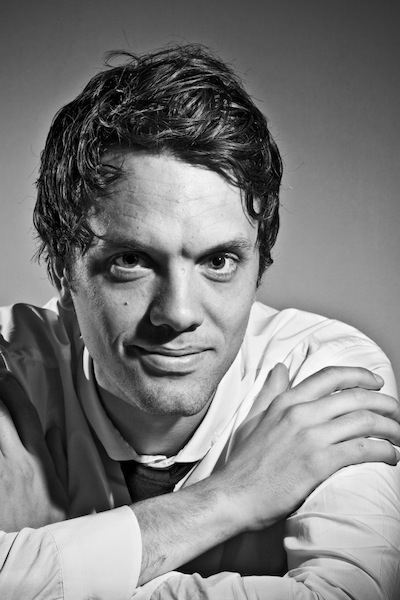Philharmonic’s new music program makes intermittent Contact

Music of Daniel Bjarnason was performed at the New York Philharmonic’s “Contact!” program Monday night at Subculture.
The New York Philharmonic’s CONTACT! new music series opened Monday night for the new season at what appears to be its ideal home, SubCulture, at the edge of the East Village. The underground nightclub has a good acoustic and was comfortably full with the large crowd the series routinely draws.
Composer John Adams played host in the intimate setting, and was alternately charming and rambling. He also compiled the music on the program, with a focus on tonal, non-minimalist chamber pieces from mostly young composers. This is always welcome in the CONTACT! series, as the label “new” intuitively has one eager to hear the thoughts of the new generation.
Those were represented by music from Daniel Bjarnason, Missy Mazzoli and Timo Andres, the generational outlier being Ingram Marshall, whom Adams strangely called an “éminence grise.” All the composers were in attendance, save for Marshall, who was not feeling up to the trip from Connecticut.
Bjarnason had two works on the program, and the concert opened with his compact cello concerto, Bow to String. The piece has an explosive opening that is immediately appealing, but it also has a fragmented feel, as if written for ears that can’t hear past two and four bar phrases, the music seemingly pandering to the simple demands of pop music fans.
But Bjarnason’s means lie in an interesting spot between contemporary classical music and the abstract core of the classical tradition. What at first sounds like a deliberately disjointed structure develops a subtle shape, as if he tossed out all his materials then slowly pulled them in and together, creating and solving a puzzle simultaneously.
There is a terrific drive that comes from combined quintuple and septuple meters. The quiet, slow middle movement is effectively disturbed by pedal tones played on a prepared string in the piano, a stimulating aesthetic contrast to the simple, long cello lines. Adams compared the final movement to Mahler—though the music lacks Mahler’s lush imagination and emotional fervor, it is frequently lovely, and the slowly shifting chords under the vocalized cello line create a romantic sense of expectation. Soloist Nathan Vickery was excellent, and the accompanying string quartet, bass, two keyboards, clarinet and french horn, were conducted with precision by Jayce Ogren.
The same composer’s Five Possibilities for clarinet, cello and piano offer a combination of Webernian brevity and Varesian density. The music carries ideas about aggression, beauty, romance, obsession and dreams. Bjarnason writes for the instruments with variety, and the unadorned statements seem deeply personal. The music was played with a sense of excitement and intrigue by clarinetist Pascual Martinez Forteza, cellist Patrick Jee and pianist Eric Huebner.
Marshall’s piece was Muddy Waters, made for the Bang on a Can All-Stars in 2004. The work is based on a hymn from the 1692 Bay Psalmbook, and, ideally, transforms the original tune compositionally and sonically. Marshall fashioned it into an isometric motet, and subjects the instrumentation—marimba, piano, cello, bass, bass clarinet and electric guitar—to his typical wash of reverb.
The transformation came off only in the end in this performance, which was mostly congested in sonority. With percussionist Daniel Druckman leading, the musicians concentrated more on counting than on expressing the music, and the coloration was never clear nor prominent enough over the club’s PA system. Some musical fire at the end was a reminder of how unique, creative and involving Marshall’s music is.
Missy Mizzoli is one of the most creative harmonists of her generation, and her piece on the program had great promise. Dissolve, O My Heart, for solo violin, was commissioned by violinist Jennifer Koh, who asked for a response to Bach’s Chaconne. So Mazzoli started with Bach’s opening phrase and wrote a piece that, in her words, “tries to be a Chaconne’” before it veers off into alternate territory.
Violinist Anna Rabinova played quietly at first, with the mute on, nicely inside the hesitant expression of the music. She later removed the mute and played at full volume, but the composition itself never opens up as one would hope. Mazzoli is so good at building chords and harmonic sequences that are both surprising and completely logical, that this piece feels like a slight disappointment. The music is solid but sounds dutiful and constrained, without her usual satisfying complexity and richness.
Wrapping up the night was Timo Andres’ Early to Rise, a commission by the Attacca Quartet, played in its New York premiere by violinists Fiona Simon and Sharon Yamada, violist Robert Rinehart and cellist Eileen Moon. Andres based the piece around a five-note figure from Schumann’s Gesäng der Frühe, and the notes are first heard in canon, then the violin and cello develop an impassioned dialogue.
Andres builds sequences of harmonic and rhythmic tension and release to move the piece forward. There is involving music, but also stretches that wander between otherwise focused dramatic gestures. The formal direction is not always secure, though the high-points are firm—the concluding section is clear, with purposeful harmonies and a finale that produces a refreshingly simple satisfaction.
The CONTACT! series continues March 7, 2015. nyphil.org